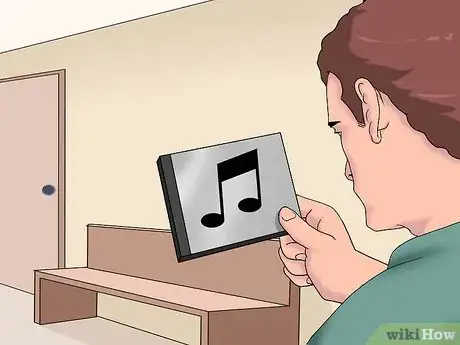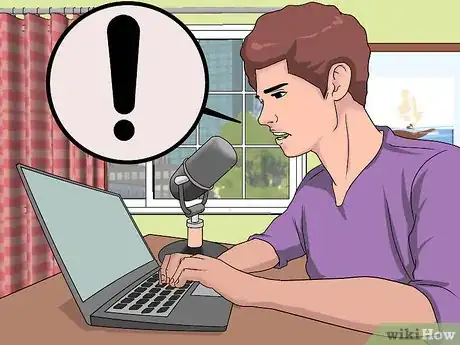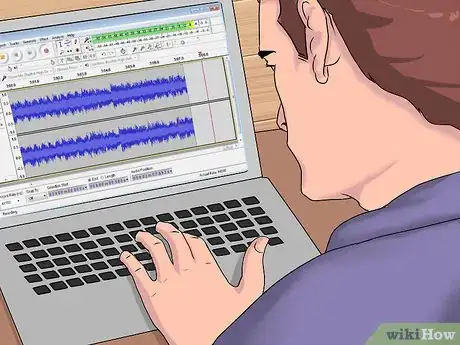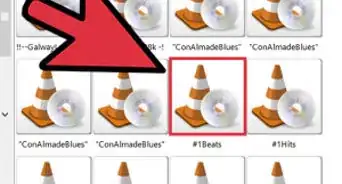This article was co-authored by Isabelle Garson. Isabelle Garson is a Social Media Expert based in the San Francisco Bay Area. With 10 years of experience, she works in social media strategy and content production. She specializes in music and cannabis marketing and has worked with international touring artists. Isabelle studied graphic design at the Academy of Art University. Additionally, she holds a certification from Sprinklr Research Analyst Pro.
There are 12 references cited in this article, which can be found at the bottom of the page.
This article has been viewed 166,769 times.
Radio is still a great technology used to reach a wide audience, whether in your local area or across the country. Radio shows can feature music, interviews, journalism, stories, or other audio content created or curated by a radio DJ or host. Learn how to get involved in this exciting and varied field, and produce a quality radio show yourself.
Steps
Obtaining a Show
-
1Contact local radio stations. Talk to radio stations in your area about buying air time or any open positions they might have for a radio host for their main programming. Talk to them about the type of show you want to have and ask about their process for new radio show hosts.
- Make sure to secure radio time on the same day and time each week or day to help build up a larger listenership of people who can expect to hear your show at a certain time.[1]
- If you’re looking to be a radio DJ and play music, contact stations that play the type of music you would want to play, i.e. alternative, country, rock, etc. The same goes for spoken audio shows: you will want to reach out to public talk radio stations about your news or documentary style show.
- If you’re in high school or college, talk to your school’s radio station about hosting your own show and what’s required for you to do so.
-
2Record an independent radio show for online broadcast. Tape a radio show using whatever equipment you have available and broadcast it online for the potential of having listeners from all over the world. Broadcast a show live online, or make it available through a podcast service.
- Podcasts are a very popular off-shoot from live radio broadcast, and a great option if you want to produce a radio show but can’t find a source to broadcast it live. Starting a podcast allows you to pre-record and edit a show before releasing it on the internet.[2]
- Try free programs like Spreaker, Radionomy, or BlogTalkRadio that can help you to record, edit, and broadcast your own radio show.[3]
Advertisement -
3Make a radio show and enter it into a contest. Create your own independent radio show using equipment available to you. Edit it and submit it to radio show contests for the chance to have it featured on a popular station or outlet, and possibly even secure your own regular broadcast.
Planning
-
1Listen to other radio shows in your genre. Listen to a wide variety of other radio shows of the type that you’re interested in, whether it’s a talk show, documentary style, or music program. Take notice of the elements that other shows have to help guide what you want to do.
- Pay attention to the things that another radio show does that keep you engaged and listening. Does the host give fun facts about the music they’re going to play or just played? Are the interviews interesting and easy to follow? Try emulating these elements in your own show.
- Also take note of the things in a show that make it drag or make you dislike it. Are there too many pauses? Is the host’s voice too monotone or too fast? Think of how you can avoid these things in your own radio show.[6]
-
2Decide on the basic components of your show. Think about and write down all the basic information about the radio show you want to create. Decide on the following key elements of your show:
- Name: Consider carefully the name you choose for your show, as it is the only thing that will stay the same in your broadcast.
- Objective: What do want to accomplish with your show? Is it to inform (informational programs, documentaries), to entertain (musical shows, radio theatre), to do a public service (interviews, reviews, special programs), etc.?
- Theme: What will you talk about? Decide on a theme or category for the type of content you produce.[7]
- Schedule: Decide on a length of time for each broadcast, how often it will air, and for how many weeks or months. Of course, this will be decided by a radio station if you broadcast through one.
- Audience: Who’s listening? Consider what age group, location, and other demographic categories you are hoping to have as key listeners.
- Show elements: What are the features of your broadcast? Are there interviews? Music? Live callers? Special guests?
- Advertising: If you need or want advertising to support your radio show, you’ll need to seek out sponsors, record advertisements, and decide how and when they’ll be placed within your show.
-
3Pick out songs for a music show. Select the songs you’ll play during a radio show that features music selections. Create a playlist or upload songs so that they’re ready to play during a live broadcast or to combine with spoken recordings for a pre-recorded show.
- In general, choose the highest quality studio recording of a song, unless you specify that you’ll be playing a live or unusual version. Remember to find the “clean” edits of songs that omit curse words if you’re broadcasting on live traditional radio.
- If taping a show that you will edit and put online, you should also record and prepare “wraps,” which are the spoken segments that introduce or recap the music played. You’ll want to edit the music files slightly, with fades or seconds of silence, so the wraps fit in more seamlessly.
-
4Interview and build a story for a news or documentary show. Plan for an informative, educational, or entertainment radio show that uses primarily spoken audio. Arrange interviews, narration, investigative research, and any other elements necessary to put together a complete story or theme.
- Conduct quality interviews by maintaining a casual, conversational style and asking your subject further questions to get more information or simply to find a piece of tape that is memorable or noteworthy for your overall story.[8]
- Note that if you’re conducting a live interview, as in one with someone live in the studio or calling in over the phone, you should do a pre-interview. This allows you to pose all the questions you will ask in the real interview so your subject is prepared for them and you know how they will answer.
- Write out an outline for the entire “story” you’re trying to build to make it easier to get the interviews you need, information you want, and “scenes” you’d like to create.[9]
-
5Write a script or outline. Write down what you will say during your show, whether it is narration to tell an overall story, questions to ask an interview subject, or wrap portions between songs in a set. Lay out a basic outline, or a more detailed word-for-word script.
- Even if your show’s dialogue is meant to be spontaneous or improvised, you should still jot down a general guideline for what to say, points to discuss if you draw a blank, and general lengths for each segment so you don’t talk too much and run over your time.
- If you’re hoping to have spontaneous dialogue or fill more time, consider having a co-host or accepting live callers. A co-host you can get along with provides easy banter and contributions so the pressure isn’t all on you, and live callers provide an element of unexpected content.[10]
Broadcasting
-
1Get familiar with a station’s equipment. Get a full tour and tutorial of equipment you’ll use for broadcasting your show through a local studio. Learn all of the functions of the technology you’ll use (like microphones, speakers, sound mixers, etc.) during live broadcasts so you feel confident operating them on the air.[11]
- Ask if you can “shadow” another radio show host to get a better feel for how equipment, signals, and procedures go during a real broadcast to learn each step as they go.
- Or ask if you can do several “dry runs” or demos before going live yourself. This sort of training is typically required by stations anyway.
- Make sure you understand how to troubleshoot or solve problems with the equipment you use. Though there may be a technician around to assist you if something goes wrong during a broadcast, it’s always best to know how you can address the issue yourself to fix it right away.
-
2Speak carefully on a live broadcast. Speak slowly and carefully on the radio so that listeners aren’t guessing at what you say or having to adjust their volume. Remember to follow guidelines for appropriate language on the radio, and consider what’s appropriate content for your target audience.
- Consult the FCC’s guidelines and your station’s own rules for what words are prohibited live on air. This should also inform what song lyrics you need to edit or not use if playing music.
- Note that while your intended audience may be adults commuting to work during your morning show, you may have listening children at that hour as well, for whom adult themes wouldn’t be appropriate. The FCC prohibits obscene content on the radio from 6 am to 10 pm.[12]
- If something goes wrong, like a live caller who’s using inappropriate language or topics, know the procedures in place with your studio and equipment on how to take yourself or a caller off the air and start playing music or another segment.
-
3Remember to announce your station’s call sign and frequency. Make sure to repeat the basic information about the radio station you’re broadcasting from, as well as your name and/or the name of your show. Remember that listeners could tune in at any time during your show segment, and want to identify what they’re listening to.
- A radio call sign is the string of four letters that designates the unique transmitting station. The frequency is the number that listeners dial on their radio to get the station’s broadcast. Usually both of these are used to announce and market the station.
- Consult the staff at your station for their guidelines on how often you should be reiterating the station’s information, as is may vary by station or show. In general, you should introduce the station and your show’s name at the beginning of every wrap portion between music or advertising.
- Even if you have a pre-recorded show or podcast, you may want to repeat your show’s name after any advertisements you may have included. While you aren’t “marketing” your show or a station as you would with live radio, you can still get the name of your show out there to help get more listeners talking about it on social media, blogs, etc.
Broadcasting Online
-
1Record with built-in or external equipment. Record the audio for your independent radio show, including any narration, wrap portions, sound clips, or interviews you might include in your show. Use any recording equipment you have available to you, or just the built-in microphone in your computer or phone.
- If you’re using external equipment, just make sure you can easily sync your recorded material with your computer or whatever device you’ll use for editing.
- If you’re making a show for music, make sure you have all the music files you want to play available on your computer or other device.
- You can also choose to record directly within a computer or phone application that let’s you edit the audio as well. Check out popular apps like Spreaker or Audacity to do this.
-
2Use editing software to put it all together. Import all of your audio files into an editing program that allows you to cut, move, change, and add effects to your audio to turn it into one complete episode of a radio show. Be sure to make copies and save your work in case you lose something accidentally.
- Find free editing software that’s easy to use by opting for an application like Audacity, Acoustica, or WavePad.[13]
- Try out premium editing software like FL Studio, Adobe Audition, or Sound Forge if you’re really into audio editing and need a full suite of controls.[14]
- While the editing will depend on your own content and style, some good practices to keep in mind are to edit out unnecessary or very long clips, create space between songs and sections using fades or music, and don’t leave more than a few seconds of empty silence in a recording.
-
3Share it on hosting sites and social media. Upload your final episode of a radio show onto any platform that hosts audio files or radio shows. Then distribute it using social media sites, a blog, a website, etc.
- Choose a platform for all sorts of audio by uploading your radio show to a well-known service like YouTube, iTunes, or SoundCloud. These have large audiences for the potential to gain more listeners.
- Try a platform specifically for hosting radio shows, like Archive.org, Podomatic, and BlogTalkRadio, which may have additional helpful tools to schedule the release of your episodes.[15]
Community Q&A
-
QuestionDoes the type of speaking voice matter in a radio show host?
 Community AnswerYou can have any sort of speaking voice to host a radio show, as long as you speak slowly and clearly in such away that all listeners can understand you. Some people have naturally more animated or varied ways of speaking which can better grasp their audience's attention, but this is a quality that anyone can achieve with practice.
Community AnswerYou can have any sort of speaking voice to host a radio show, as long as you speak slowly and clearly in such away that all listeners can understand you. Some people have naturally more animated or varied ways of speaking which can better grasp their audience's attention, but this is a quality that anyone can achieve with practice. -
QuestionHow do I find listeners for a new online radio show?
 Community AnswerSpread the word! Post on your social media, tell your friends, even hand out flyers.
Community AnswerSpread the word! Post on your social media, tell your friends, even hand out flyers. -
QuestionHow can I do a radio show in English?
 Community AnswerYou can learn the language, or bring on someone who already speaks English.
Community AnswerYou can learn the language, or bring on someone who already speaks English.
Expert Interview

Thanks for reading our article! If you'd like to learn more about becoming a a radio show host, check out our in-depth interview with Isabelle Garson.
References
- ↑ http://1490wwpr.com/how-to-radio/how-to-host-a-radio-show/
- ↑ http://www.huffingtonpost.com/paul-jarvis/starting-a-podcast-for-pe_b_8383700.html
- ↑ https://www.spreaker.com/create-a-radio-show
- ↑ https://www.spreaker.com/create-a-radio-show
- ↑ http://www.radiotopia.fm/podquest/
- ↑ http://1490wwpr.com/how-to-radio/how-to-host-a-radio-show/
- ↑ http://1490wwpr.com/how-to-radio/radio-talk-show-topics/
- ↑ http://transom.org/2013/the-basics/
- ↑ https://www.scribd.com/doc/198426785/Story-Planning-Worksheet
- ↑ http://1490wwpr.com/how-to-radio/how-to-host-a-radio-show/
- ↑ http://www.radiodiaries.org/trh/technical-tips/
- ↑ https://www.fcc.gov/consumers/guides/obscene-indecent-and-profane-broadcasts
- ↑ http://mashable.com/2013/07/27/editor-audio-free/#sruPjpwB5sq7
- ↑ http://beebom.com/best-audio-editing-software/
- ↑ http://www.technorms.com/37746/best-sites-to-host-your-podcasts
About This Article
To make a radio show, start by listening to other radio shows in your genre, and taking notes on what you like best. Next, work on coming up with a name and theme for your show. Additionally, decide how long each show will be, how often it'll air, and who the target audience is. Before recording the show, write a script or an outline to help you stay on track. Once your show is recorded, use editing software to put it all together, then share it on a hosting or social media site if you're interested in online broadcasting. To learn how to broadcast a live radio show, keep reading!







































































